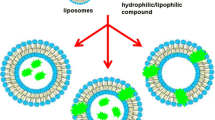Abstract
Lipid-based self-assembling vesicles were first described in 1961 and reported in 1964 by Dr. Alec D. Bangham (Bangham and Horne in J Mol Biol 8:660–668, 1964) at the Babraham Institute in Cambridge, UK, in which he wrote: “It is probable that at equilibrium each and every lipid bilayer forms an unbroken membrane-there being no exposed hydrocarbon/water interface-from which it follows that every aqueous compartment would be discrete and isolated from its neighbor, including a complete separation of the outermost compartment of the whole structure from the continuous phase in which it is suspended”. It is thermodynamically possible for each lipid bilayer to form a discrete membrane, separating the vesicle from the continuous aqueous phase in which it is suspended. These “unbroken membranes” were called as “liquid crystal” or “smectic mesophase”, “Bangasomes” after the name of Dr. Bangham, and finally “liposomes”. The word “liposome” derives from two Greek words of “lipo-meaning fat” and “soma-meaning body”. In the earlier days, these artificial vesicles (or liposomes) were used for the study of cell physiology such as ion (or drug) permeability, membrane fusion, membrane-bound enzyme properties or as a membrane model. More recently, much attention was brought to the uses of liposomes in medical fields as drug delivery systems and the first article of this kind was published in 1971 in FEBS Letters by Dr. George Gregoriadis and his co-workers, where amyloglucosidase and albumin were entrapped into liposome for the purpose of enzyme replacement therapy (Gregoriadis et al. in FEBS Lett 14(2):95–99, 1971). Since then, tremendous amounts of papers were published on the uses of liposomes as a drug delivery system (DDS). So, this mini-review is mainly focused on the use of liposome as DDS.

Similar content being viewed by others
References
Alton EW, Boyd AC, Porteous DJ, Davies G, Davies JC, Griesenbach U, Higgins TE, Gill DR, Hyde SC, Innes JA, UK Cystic Fibrosis Gene Therapy Consortium (2015) A phase I/IIa safety and efficacy study of nebulized liposome-mediated gene therapy for cystic fibrosis supports a multidose trial. Am J Respir Crit Care Med 192(11):1389–1392
Bangham AD, Horne RW (1964) Negative staining of phospholipids and their structural modification by surface-active agents as observed in the electron microscope. J Mol Biol 8:660–668
Ehrlich P (1906) Collected studies on immunity. Wiley, New York
Gregoriadis G, Neerunjun ED (1975) Homing of liposomes to target cells. Biochem Biophys Res Commun 65(2):537–544
Gregoriadis G, Leathwood PD, Ryman BE (1971) Enzyme entrapment in liposomes. FEBS Lett 14(2):95–99
Lee RJ, Low PS (1994) Delivery of liposomes into cultured KB cells via folate receptor-mediated endocytosis. J Biol Chem 269(5):3198–3204
Leserman LD, Weinstein JN, Blumenthal R, Terry WD (1980) Receptor-mediated endocytosis of antibody-opsonized liposomes by tumor cells. Proc Natl Acad Sci USA 77(7):4089–4093
Leserman LD, Machy P, Barbet J (1981) Cell-specific drug transfer from liposomes bearing monoclonal antibodies. Nature 293(5829):226–228
Madni A, Sarfraz M, Rehman M, Ahmad M, Akhtar N, Ahmad S, Tahir N, Ijaz S, Al-Kassas R, Löbenberg R (2014) Liposomal drug delivery: a versatile platform for challenging clinical applications. J Pharm Pharm Sci 17(3):401–426
Matsumura Y, Maeda H (1986) A new concept for macromolecular therapeutics in cancer chemotherapy: mechanism of tumoritropic accumulation of proteins and the antitumor agent SMANCS. Cancer Res 46:6387–6392
Papahadjopoulos D, Allen TM, Gabizon A, Mayhew E, Matthay K, Huang SK, Lee KD, Woodle MC, Lasic DD, Redemann C et al (1991) Sterically stabilized liposomes: improvements in pharmacokinetics and antitumor therapeutic efficacy. Proc Natl Acad Sci USA 88(24):11460–11464
Sorscher EJ, Logan JJ, Frizzell RA, Lyrene RK, Bebok Z, Dong JY, Duvall MD, Felgner PL, Matalon S, Walker L et al (1994) Gene therapy for cystic fibrosis using cationic liposome mediated gene transfer: a phase I trial of safety and efficacy in the nasal airway. Hum Gene Ther 5(10):1259–1277
Torchilin VP, Khaw BA, Smirnov VN, Haber E (1979) Preservation of antibody activity after covalent coupling to liposomes. Biochem Biophys Res Commun 89(4):1114–1119
Wang CY, Huang L (1987) pH-sensitive immunoliposomes mediate target-cell-specific delivery and controlled expression of a foreign gene in mouse. Proc Natl Acad Sci (USA) 84(22):7851–7855
Weinstein JN, Magin RL, Yatvin MB, Zaharko DS (1979) Liposomes and local hyperthermia: selective delivery of methotrexate to heated tumors. Science 204(4389):188–191
Yatvin MB, Weinstein JN, Dennis WH, Blumenthal R (1978) Design of liposomes for enhanced local release of drugs by hyperthermia. Science 202(4374):1290–1293
Yatvin MB, Kreutz W, Horwitz BA, Shinitzky M (1980) pH-sensitive liposomes: possible clinical implications. Science 210(4475):1253–1255
Acknowledgments
Jin-Seok Kim declares that he has no conflict of interest.
Author information
Authors and Affiliations
Corresponding author
Rights and permissions
About this article
Cite this article
Kim, JS. Liposomal drug delivery system. Journal of Pharmaceutical Investigation 46, 387–392 (2016). https://doi.org/10.1007/s40005-016-0260-1
Received:
Accepted:
Published:
Issue Date:
DOI: https://doi.org/10.1007/s40005-016-0260-1




